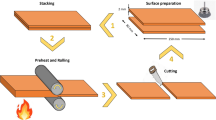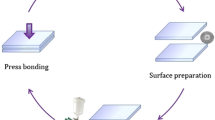Abstract
The forming limit diagram (FLD), mechanical properties and fracture toughness of aluminum foil composites fabricated via accumulative roll bonding (ARB) process have been investigated as its novelty for the first time. To do this, AA1050/TiC composite foils with thickness of 0.2 mm have been fabricated from one up to twelve ARB passes at 320 °C. Also, optical microscopy (OM) was used to investigate the effect of cumulative forming process on the grain structure. The strength of samples improved to 168. 6 MPa after the 12th cumulative rolling pass, registering 248% improvement in comparison with initial AA1050 sample. Also, by cumulating the plastic strain at higher passes, the bonding quality among composite layers enhanced. SEM fracture surface morphology of samples showed the conversion of fracture mode to shear mode for composites fabricated at high number of passes. So, in comparison with the annealed sample, deep dimples are shrinking slowly and their number and depth were reduced. As the criterion of formability and at higher passes, the area under the FLDs, dropped sharply for one pass processed sample and then improved. Results of fracture test revealed that the value of fracture toughness enhanced continually and got to the 30 MPa.m1/2 at the 12th pass. Grain refinement and ARB process nature are two main mechanisms which are responsible for all ductility changes and mechanical properties.





















Similar content being viewed by others
References
Jamaati R, Toroghinejad MR (2010) Manufacturing of high-strength aluminum / alumina composite by accumulative roll bonding. Mater Sci Eng A 527(16–17):4146–4151
Amirkhanlou S, Jamaati R, Niroumand B, Toroghinejad MR (2011) Using ARB process as a solution for dilemma of Si and Sic P distribution in cast Al – Si / Sic P composites. J Mater Process Technol 211(6):1159–1165
Saito Y, Utsunomiya H, Tsuji N, Saito Y, Utsunomiya H, Tsuji N, Sakai T (1999) Novel ultra-high straining process for bulk materials-development of the accumulative roll-bonding (ARB) process. Acta Mater 47(2):579–583
Vini MH, Daneshmand S (2020) Fabrication of bimetal aluminum-5% alumina-bromine composites by warm accumulative roll bonding. J Test Eval 49(4):2757–2766
Liu CY, Wang Q, Jia YZ, Zhang B, Jing R, Ma MZ, Jing Q, Liu RP (2012) Effect of w particles on the properties of accumulatively roll-bonded Al/W composites. Mater Sci Eng A 547:120–124
Korbel A, Richert M, Richert J (1981) The effects of very high cumulative deformation on structure and mechanical properties of aluminium. In: Proceedings of the second RISO international symposium on metallurgy and material science, Riso national laboratory: Roskilde, Denmark, p 14–18
Lu C, Tieu K, Wexler D (2009) Significant enhancement of bond strength in the accumulative roll bonding process using nano-sized Sio2 particles. J Mater Process Technol 209(10):4830–4834
Alizadeh M, Talebian M (2012) Fabrication of Al/Cup composite by accumulative roll bonding process and investigation of mechanical properties. Mater Sci Eng A 558:331–337
Liu CY, Wang Q, Jia YZ, Zhang B, Jing R, Ma MZ, Jing Q, Liu RP (2013) Evaluation of mechanical properties of 1060-Al reinforced with WC particles via warm accumulative roll bonding process. Mater Des 43:367–372
Alizadeh M (2010) Comparison of nanostructured Al / B4C composite produced by ARB and Al / B4C composite produced by RRB process. Mater Sci Eng A 528(2):578–582
Farhadipour P, Sedighi M, Heydari M (2017) Using warm accumulative roll bonding method to produce Al-Al2O3. Proc Inst Mech Eng Part B J Eng Manuf 231(5):889–896
Ipek R (2005) Adhesive wear behaviour of B4C and Sic reinforced 4147 Al matrix composites (Al/B4C-Al/SiC). J Mater Process Technol 162–163:71–75
Su L, Lu C, Li H, Deng G, Tieu K (2014) Investigation of ultrafine grained AA1050 fabricated by Accumulative Roll Bonding. Mater Sci Eng A 614:148–155
Vini MH, Daneshmand S (2019) Top of form bottom of Form Effect of electrically assisted accumulative roll bonding (EARB) process on the mechanical properties and microstructure evolution of AA5083/Al2O3 composites. Mater Perform Charact 8(1):594–603
Pasebani S, Toroghinejad MR (2010) Nano-grained 70–30 brass Strip produced by accumulative roll-bonding (ARB) process. Mater Sci Engineering: A 527(3):491–497
Heydari Vini M, Sedighi M, Mondali M (2017) Mechanical properties and microstructural evolution of AA5083/Al2O3 composites fabricated by warm accumulative roll bonding. ADMT J 9(4):13–22
Habibi M, Hashemi R, Fallah Tafti M, Assempour A (2018) Experimental investigation of mechanical properties, formability and forming limit diagrams for tailor-welded blanks produced by friction stir welding. J Manuf Processes 31:310–323
Rahmatabadi D, Tayyebi M, Hashemi R, Faraji G (2018) Microstructure and mechanical properties of Al/Cu/Mg laminated composite sheets produced by the ARB proces. Int J Miner Metall Mater 25(5):564–572
Alisaraei EA, Hashemi R, Rahmatabadi D, Sommitsch C (2020) Experimental study of forming limit diagram and mechanical properties of aluminum foils processed by the accumulative roll bonding. Mater Res express. https://doi.org/10.1088/2053-1591/abced9
Acknowledgements
The authors gratefully acknowledge the Islamic Azad university Majlesi Branch for the provision of research facilities used in this work.
Author information
Authors and Affiliations
Corresponding author
Ethics declarations
Conflict of interest
No potential conflict of interest was reported by the author(s).
Additional information
Publisher’s note
Springer Nature remains neutral with regard to jurisdictional claims in published maps and institutional affiliations.
Rights and permissions
Springer Nature or its licensor (e.g. a society or other partner) holds exclusive rights to this article under a publishing agreement with the author(s) or other rightsholder(s); author self-archiving of the accepted manuscript version of this article is solely governed by the terms of such publishing agreement and applicable law.
About this article
Cite this article
Vini, M.H., Daneshmand, S. Forming limit diagram and plane stress fracture toughness of foil AA1050/TiC composites. Int J Mater Form 16, 43 (2023). https://doi.org/10.1007/s12289-023-01764-1
Received:
Accepted:
Published:
DOI: https://doi.org/10.1007/s12289-023-01764-1




